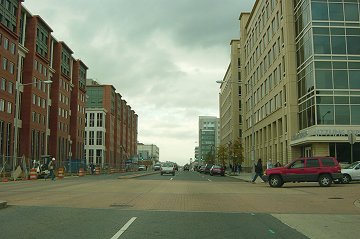Office ghettos aren't quality economic development
Marc Weiss argues in the "Close to Home" feature of the Washington Post that "Southeast Is Doing Fine Without a Stadium." While I agree that a baseball stadium, and sports-related projects of this type aren't necessarily sound economic development, and certainly the rate of return on investment is negligible, I do think that the kind of "economic development" that Dr. Weiss promotes needs to be challenged.
He speaks highly of the move of the Naval Sea Systems Command from Crystal City, and the resultant development of office buildings along M Street S.E.
While the amount of construction has been impressive, and likely the increase in property tax revenue is significant, what has been produced is merely another office ghetto--antiseptic during the day, and barren at night and on weekends. (Does anyone hang on K Street NW after 6 pm?)
I don't have photos handy, but the best source around for photos and tracking of development in and around the M Street SE-SW corridor is the Near Southeast DC Redevelopment blog. (I'm taking the liberty of utilizing one of the blog's photos to illustrate the point, as well as to show you why you need to check out that blog.)
 DOT frontage, just a bit west of 4th Street on M, 11/05. Photo by Jacqueline Dupree.
DOT frontage, just a bit west of 4th Street on M, 11/05. Photo by Jacqueline Dupree.Office ghettos like M Street SE (or K Street NW) violate the "mixed primary use" principle laid out by Jane Jacobs more than 40 years ago. After 6 pm, and all day on weekends, M Street S.E. is dark and forlorn, seemingly abandoned, and feels unsafe. Had housing and other uses been integrated into development on the corridor and required by a small area plan, this could have been avoided. (See these resources on mixed use development and this for "successful infill development".)
I know people will say these uses are coming, such as through the redevelopment of the Capper-Carrollsburg housing project, but the jury is still out on how much this can begin to re-balance the dominance of daytime-focused office buildings in the general area. And housing for seniors and the Marines (extant) (which Dr. Weiss mentions) probably doesn't add enough oomph economically in a manner that can generate more organic retail options.
Most of the workers in the buildings work for military contractors and they tend to live in the suburbs, and they don't patronize many city establishments or linger much after work. The publisher of the Voice of the Hill once remarked to me that he stopped delivering papers to the restaurants and buildings along M Street SE, because month after month the papers sat there unread--the office workers had no interest in the goings on of the Greater Capitol Hill area in which they work.
Even a baseball stadium isn't likely to be as positive as people think, because the complementary entertainment district has to be created from scratch, and new construction means high rents that are likely to crowd out non-chain offerings. Plus, what about the other 265 days of the year (figuring at least 20 non-baseball events/year)?
Still and all, Dr. Weiss' organization has an interesting website (in fact, I'll be adding it to my set of links), and his conclusion, that:
"Making [transportation and infrastructure] investments is more important for economic development than spending lavishly on an 'ultra-modern' stadium"
can't be denied.
I think about the amount of necessary for a new DC baseball stadium, and how it could be spent to bring to fruition the various streetcar-BRT proposals contained within the DC Transit Future project and I shake my head... Such investments are likely to spur private investment 10 to 15 times greater than the amount of public money invested.
Index Keywords: mixed-use



0 Comments:
Post a Comment
<< Home